21 Most Beautiful Dordogne Towns and Villages to Visit
Magnificent castles, beautiful medieval villages, a dreamy bucolic landscape, bustling markets, a bountiful gastronomy – Dordogne in southwest France has long been a big draw for its beautiful small country towns
The third largest department of France, forming part of the Nouvelle-Aquitaine region, the Dordogne department is more commonly called the Périgord by the French.
Why? This was the former name of the province prior to the 1789 Revolution!
For all extents and purposes, the geography of ancient Périgord pretty much equates to the boundaries of Dordogne today!
This article was written by Rebecca Legros, a travel writer originally from Britain who moved to France 13 years ago. Now based in Bordeaux, she spent 3 years living in Dordogne and is sharing her expertise on one of her favorite parts of France here. Take it away, Rebecca!
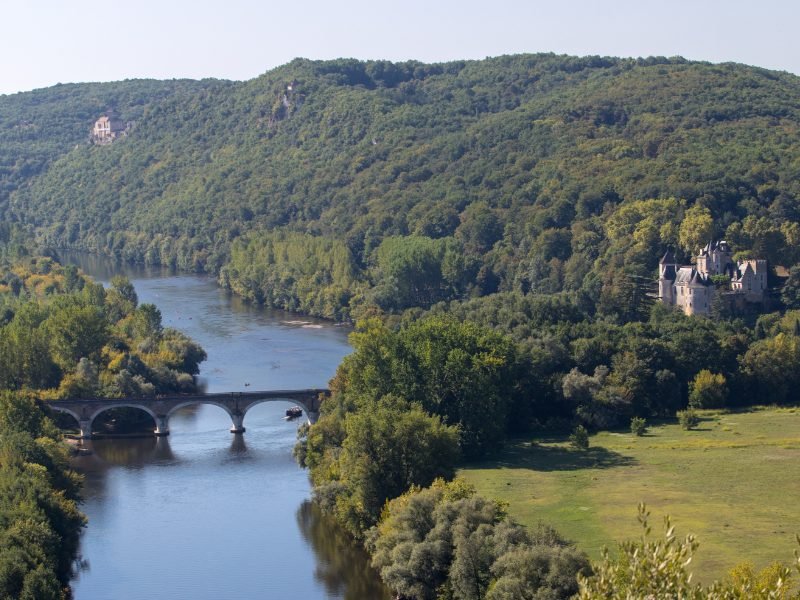
The department is divided into four distinct areas rooted in the region’s natural attributes: Noir (black), Blanc (white), Vert (green) and Pourpre (purple).
Together, these areas shape a part of France famed for its unspoiled natural beauty, laid-back lifestyle, cultural heritage, culinary delights, and a wealth of wonderful towns and villages in Dordogne!
So, let’s take a closer look at Dordogne’s most beautiful small towns, broken down by these four areas.
Table of Contents
The Most Beautiful Towns in Dordogne’s Périgord Noir
The Périgord Noir in south-east Dordogne merits this name because it’s rich in oak and pine forests with dark, dense foliage.
It’s also the seat of some of the most beautiful of all of Dordogne’s picture-postcard towns and villages, as well as a profusion of other popular sites — and some of the most beautiful villages of France, period.
Sarlat-la-Canéda
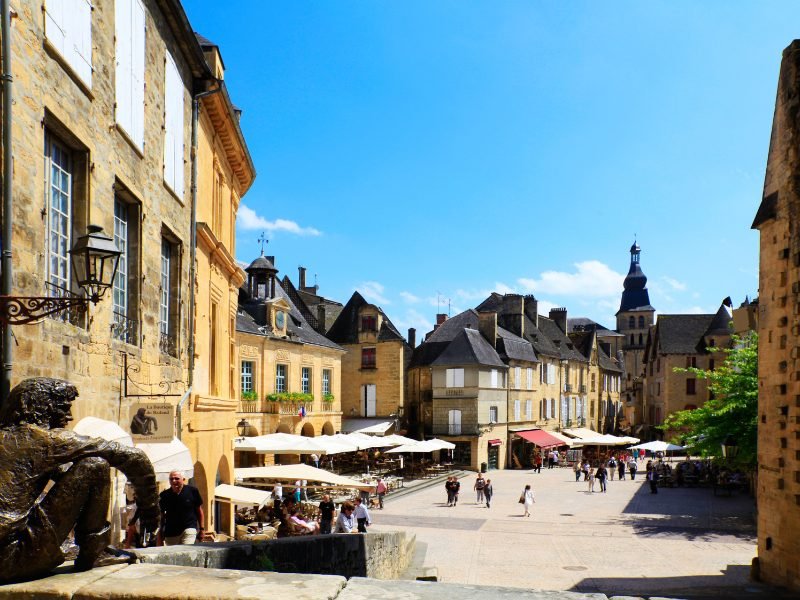
The perfectly-preserved ancient medieval town of Sarlat is perhaps the most sublime in all of Périgord!
With well over 200 listed buildings dating from the 14th century onward, it’s also one of the most visited medieval towns in France.
Sarlat’s historic center is the ultimate fairytale town, crammed with characteristic limestone architecture and cobbled streets that are a dream to get lost in.
A great way to take in this extensive example of medieval heritage is from above!
Get a panoramic view of Sarlat from the top of the Sainte-Marie Church in the impressive glass elevator designed by famous French architect, Jean Nouvel.
It’s a uniquely modern way to get a stunning view of this picturesque village!
Domme
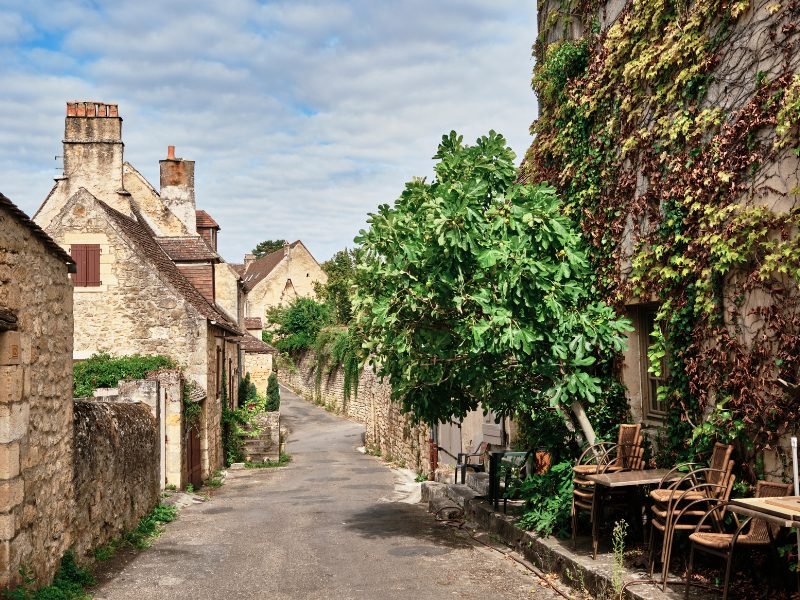
Surrounding Sarlat are a cluster of Les Plus Beaux Villages de France.
What does that mean? These are designated Most Beautiful Villages in France, and Domme is one such beautiful small village!
Suspended high on a hilltop with the Dordogne River meandering serenely below, the village offers splendid vistas of the Dordogne Valley.
Domme dates from the 13th century and is a great example of a bastide – or fortified townl
Its architecture is a blend of buildings: a mix of half-timbered houses and others built in the attractive local limestone.
The original walls of the stronghold still surround the village, and a ride on the tourist train gives a great overview of both the ramparts and lovely cottage-lined streets.
Want something unique?
Explore the network of caves that run deep through the rocky outcrop on which the village is perched!
La Roque-Gageac
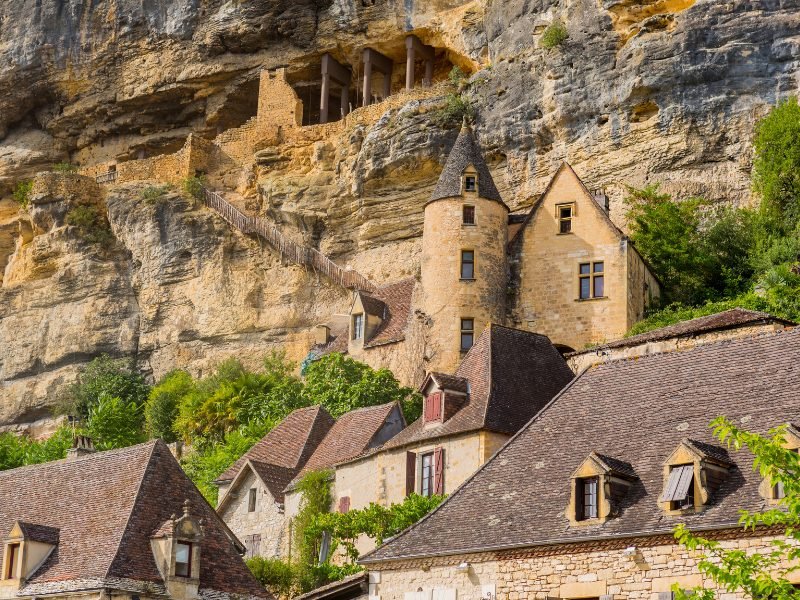
France’s Plus Beaux Villages Association has designated Dordogne with no less than ten of France’s Most Beautiful Villages.
Along with Aveyron, the Dordogne region has the highest density of plus beaux villages of any department in the country!
La Roque-Gageac, on the banks of the Dordogne River, is another of these eye-catching classified villages.
Rows of chocolate-box, honey-colored houses built into the cliffside along pretty streets run along this striking stretch of the river.
One of the highlights here is a taking a boat ride in a Gabarre – a traditional boat used in the Middle Ages to transport goods along the waterways of the region.
Coast along past age-old castles and outstanding scenery, and savor a great view of one of France’s best-loved landscapes!
Beynac-et-Cazenac
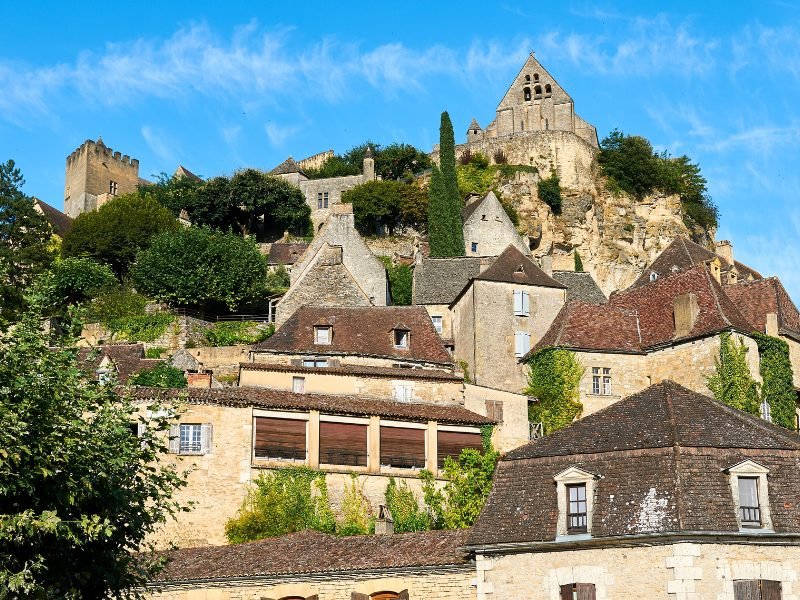
A short drive from La Roque-Gageac is another plus beau village beauty and a classic example of a historic Dordogne village.
A crowd-pleaser with cute cobblestoned streets and even more photogenic façades, the crowning glory of Beynac-et-Cazenac is its stately clifftop castle with commanding views of the surrounding countryside.
Admire the village high on its lofty perch from a river boat, or amble the narrow walkways with historical buildings where movies like Chocolat and The Last Duel were filmed.
Don’t miss out on the nearby Jardins de Marqueyssac, France’s famous hanging gardens set between Beynac-et-Cazenac and La Roque-Gageac.
Noted for its fine-looking topiaries and far-reaching valley views, these gardens are a Dordogne delight.
Castelnaud-la-Chapelle

Directly across the Dordogne River from Beynac-et-Cazenac is the plus beau village of Castelnaud-la-Chapelle.
Its stronghold sits strategically on a soaring outcrop overlooking the valley, and it’s the most visited château in southern France!
Dordogne is commonly called the Land of 1001 Castles, and in the Middle Ages many fine fortresses like the one here were constructed.
These fortresses were built during the Hundred Years War between the French and the English, and were so well-built that many still stand to this day.
Of course, you’ll want to wander through the picturesque streets and narrow lanes of this tiny village on your walk up to the castle.
You should also include a visit to the Museum of Medieval Warfare in the château grounds for a taste of life in those turbulent war years a thousand years ago!
For more of a Renaissance château experience, visit Château Milandes a few miles down the road, the impressive former home of American dancer and singer Josephine Baker.
Belvès
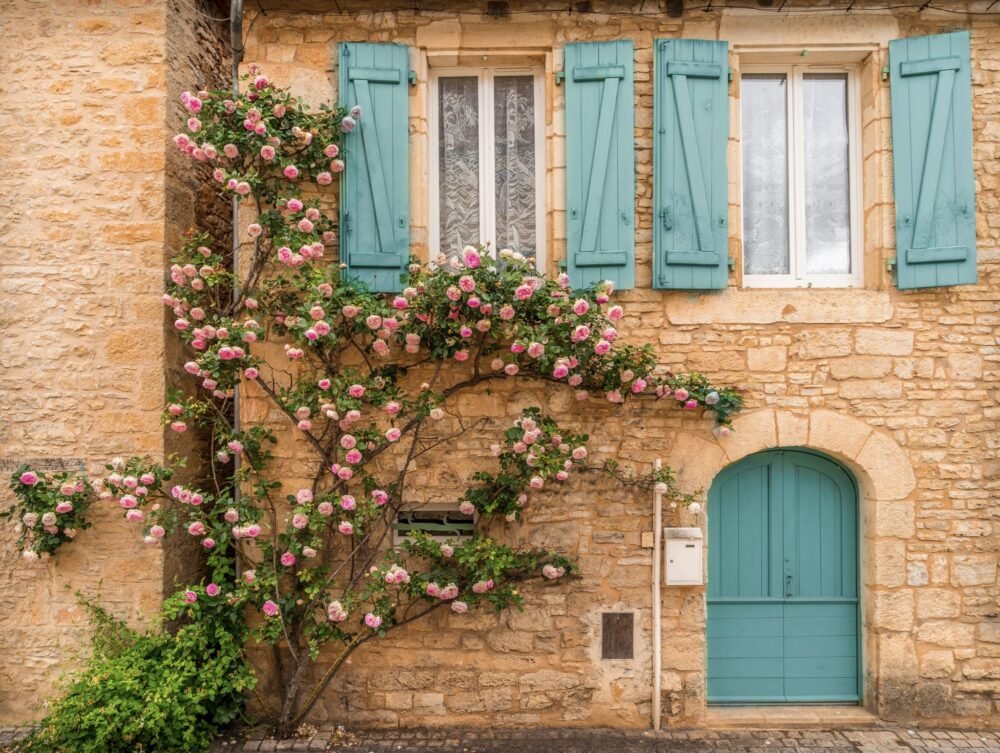
Another lively bastide town, Belvès is another official plus beau village on the Dordogne tourist trail and one of the prettiest villages in the Dordogne.
The large main square has a remarkably well-preserved 15th century halle at its heart – a traditional covered local market.
Saturday mornings are a wonderfully animated affair when market day is in full swing, so time your visit here for a Saturday if it’s at all possible!
Selling specialty Dordogne delicacies like truffles, foie gras, cheese, honey, walnuts and duck, enjoy the time-honored French tradition of market day in this lovely little town.
With time to spare, you can even venture under the central square and discover the troglodyte caves, which functioned as dwellings for the local peasants until the 18th century.
Les Eyzies
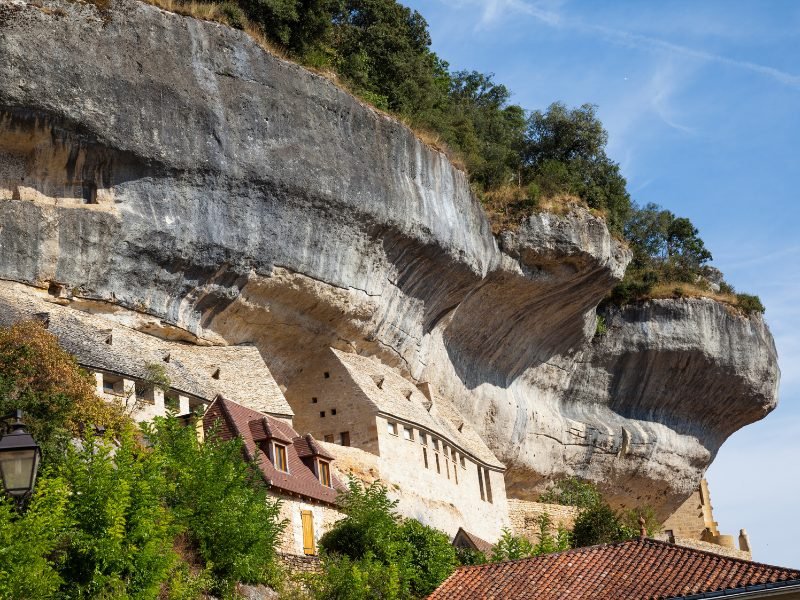
Dordogne is not only a magnet for tourists wanting to see the charms of a quaint Southern French village.
In fact, early settlers stretching back to Prehistoric Man were drawn in by the perfect cave-dwelling conditions in the region’s Vezère Valley.
So if it’s a taste of much earlier than medieval times that you’re after, the village of Les Eyzies is an ideal base!
The village lies in the center of the Vezère Valley, and is surrounded by an extraordinary landscape of limestone cliffs, rock shelters and caves.
It is here that Cro-Magnon people (prehistoric Homo sapiens) lived almost 30,000 years ago.
Also known as the Valley of Mankind, the area around Les Eyzies has an exceptional number of prehistoric sites to visit, 15 of which are collectively classified as a UNESCO World Heritage Site.
Montignac

This charming town on the River Vézère is the location of the celebrated Lascaux Cave Complex.
Discovered in 1940, these world-famous caves accommodate some of the best-preserved prehistoric paintings in the world.
As the main cultural and heritage site in Dordogne, tourists descend on Lascaux in their droves to view the 17,000-year-old cave paintings of early Man.
It’s worth knowing that if you take a guided tour, what you actually see is a replica in an authentic cave setting.
The original caves are closed to the public to prevent deterioration of the artwork.
Don’t miss out on an amble around Montignac itself; the town is postcard pretty and has a popular Wednesday morning market worth checking out.
Saint-Léon-sur-Vézère
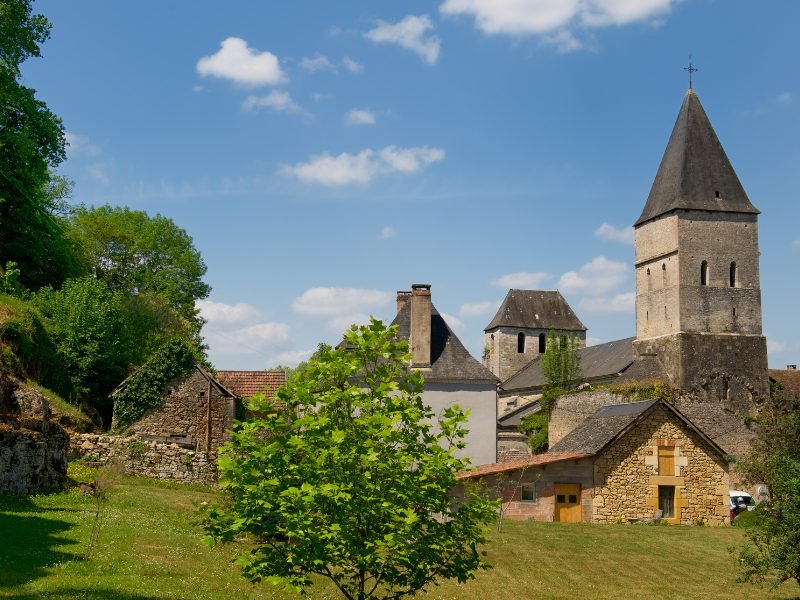
Also set on the laidback Vézère River, this lovely little village in Dordogne is another that carries the plus beau village badge.
Take a stroll along the scenic riverside, admiring the old castle and 12th century Romanesque church.
Saunter through the village streets, stopping by the charming arts and crafts stores.
Be sure to break for lunch in one of the bucolic restaurants – I highly recommend the river café Le Déjeuner sur l’Herbe, with its deliciously fresh local fare and free-roaming chickens!
For a chilled out Vezère Valley experience, rent a kayak or canoe in the village and spend a relaxing morning or afternoon trailing the river past châteaux and prehistoric sites.
There are a number of kayak rental services across the Dordogne — it’s a great place for a paddle with a beautiful view.
Saint-Amand-de-Coly
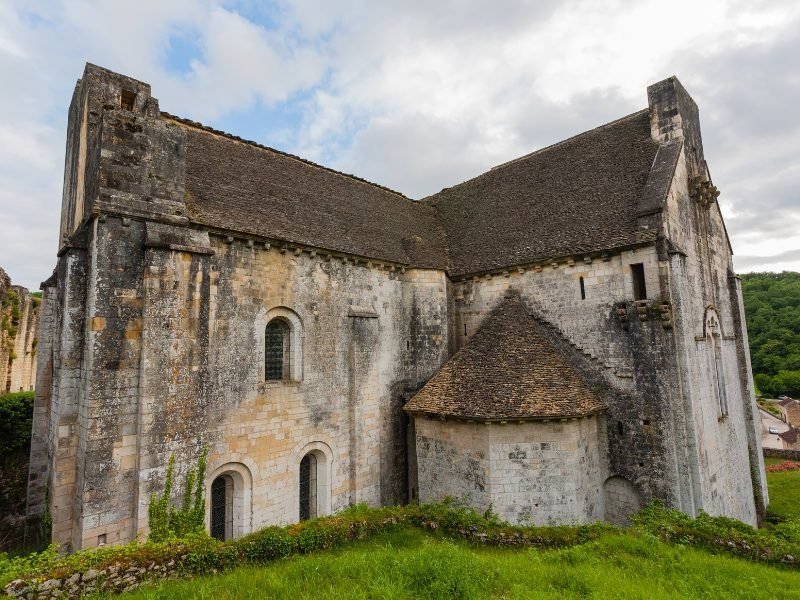
This small but perfectly formed plus beau village is fêted for its imposing 12th century abbey, a historical monument which all but dwarfs the village.
With 100-foot-high bell towers and defensive walls almost 15-foot thick, this fortified church has stood the test of time since the days of the Hundred Years War.
To learn more about the fascinating history of Saint-Amand-de-Coly, the village is well-equipped with a tourist circuit of educational panels.
The surrounding area is also perfect for walks and cycling in the wooded countryside.
Terrasson-Lavilledieu

The old town of Terrasson, up on the hill beyond the banks of the River Vézère, is a charming collection of cream-colored and colombage buildings.
The Place Bouquier is the pretty central square where, after a stroll along the town’s scenic ramparts, lunch or drinks on a café terrace is highly recommended.
When in town, be sure to take in the main attraction, the Jardins de l’Imaginaire.
These splendid gardens are classified by the French Ministry of Culture as an enchanting landscape celebrating the art of horticulture!
Hautefort

In the very north of the Périgord Noir lies the lovely village of Hautefort, home to the most magnificent Renaissance château, Château de Hautefort.
The castle started life as a medieval fortress — but as with many medieval castles, it lived several purposes later in its existence.
Over time, it grew into a grandiose palace for the privileged owners who wanted their leisurely lives to mirror the extravagances of the Loire Valley châteaux.
Château de Hautefort is today a listed historical building in France, and sits in superb landscaped grounds overlooking the village and the verdant valley beyond.
The Most Beautiful Villages in Dordogne in Périgord Vert
The Périgord Vert encompasses the northern reaches of Dordogne, and is a landscape of rolling hills and lush valleys.
While the Périgord Noir has a claim on so many of the region’s hotspots, it’s also rather busy.
To get more off the tourist trail, particularly in the overcrowded summer months, it’s worth diverging from the hub of the action.
Start by discovering some of the lesser known gems of Dordogne in the lesser-visited regions, like Périgord Vert, Blanc, and Pourpre.
Saint-Jean-de-Côle

The beguiling little village of Saint-Jean-de-Côle is the only one in the Périgord Vert to hold official plus beau villagestatus.
With a history going back to the 11th century, it boasts plenty of medieval village charm and is one of the most interesting old villages of Dordogne.
It also has many listed historical monuments, such as its Byzantine church and Château de la Marthonie.
Saint-Jean-de-Côle is especially fun to visit during its annual Spring Flower Festival held in early May.
Dressed up in dazzling floral displays, the village in bloom brings in hundreds of visitors during its festival.
If you visit during this May festival, enjoy a day out browsing craft stalls, feasting on fresh local produce and delighting in music and dance performances.
Brantôme
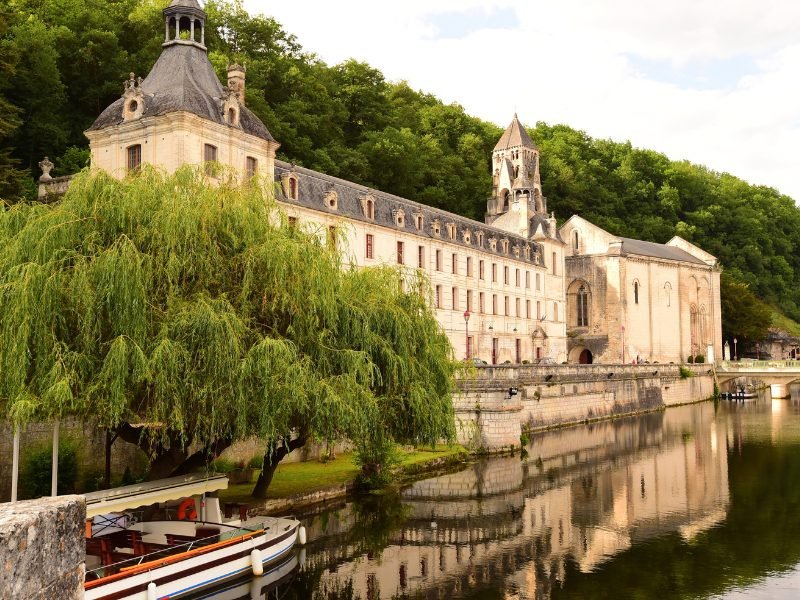
The small town of Brantôme is quite the treasure, one of the best towns in the Dordogne.
This charming town is dominated by its ancient buildings such as the illustrious Benedictine Abbey, built in the 8th century by Charlemagne, a one-time distinguished king of France.
This Dordogne town is pretty as a picture, as a wander along the riverbank, over the old stone bridge, past the watermill and weir, and across to the imposing abbey will soon prove.
For an extra special time, treat yourself to a stay at Le Moulin de l’Abbaye.
This sumptuous Relais & Châteaux hotel was fashioned from the former mill — and now it has a Michelin-starred restaurant and splendid views of the river and abbey.
The Most Beautiful Villages in Dordogne in Périgord Blanc
In the heart of the department of the Dordogne, set on the limestone plateau from which much of the region’s stonework is crafted, lies the Périgord Blanc.
This small sub-region of Dordogne is home to the pretty department capital of Périgueux.
Périgueux
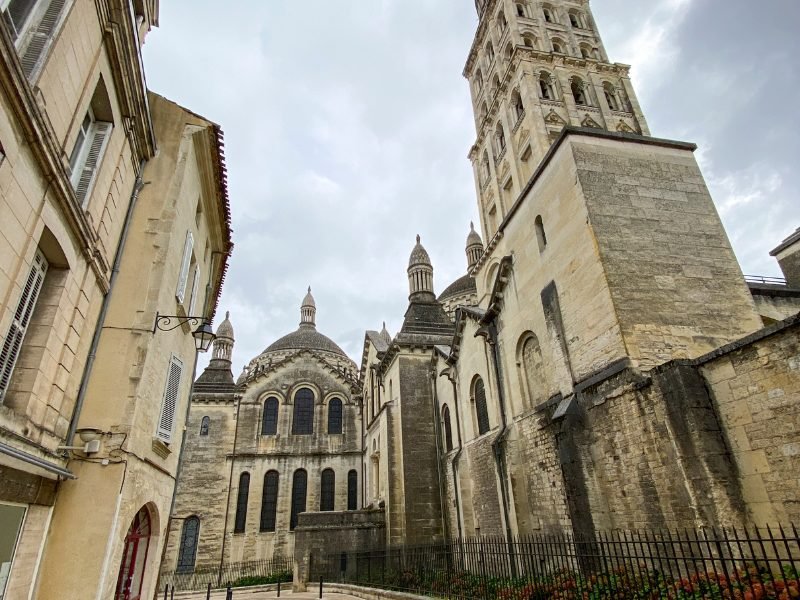
The most-populated town of Périgord and the region’s prefecture, Périgueux is the perfect place to base yourself to venture around the North and Central Dordogne.
With an historical heritage spanning from Gallic to Roman, medieval to Renaissance, there is plenty to see.
Of particular interest is the St Front Cathedral.
It is listed as a UNESCO World Heritage Site as part of the pilgrim route to Santiago de Compostella!
You also shouldn’t miss its central square with a wonderful Wednesday and weekend market, one of the largest in the region.
The Gallo-Roman museum of Vesunna is also quite the magnet in Périgueux.
It’s an outstanding example of an unearthed Roman villa, as well as other artifacts, all housed in a marvelous glass structure designed by Jean Nouvel.
Tourtoirac
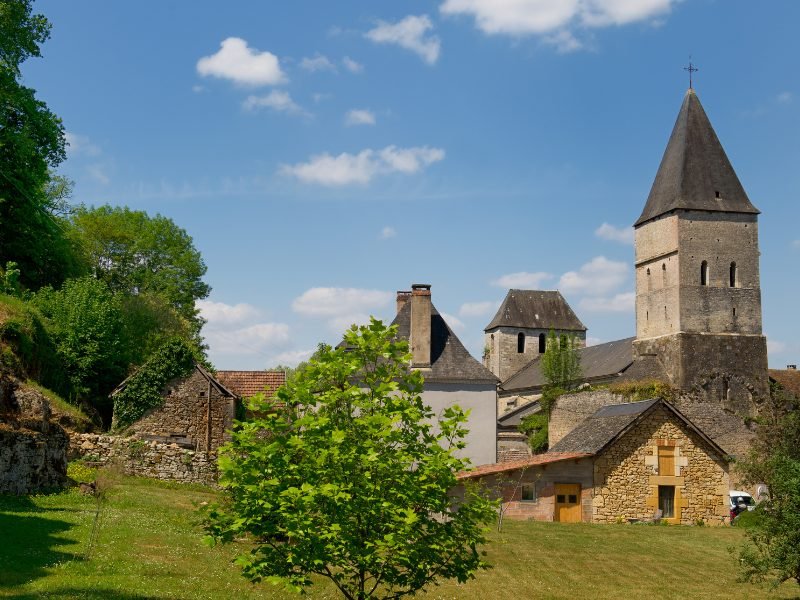
One of the best places to get a bit off the beaten path, Tourtoirac is an ideal place to unwind in Dordogne.
Far from the main towns of the Dordogne, Tourtoirac doesn’t have a worldwide reputation as a popular holiday destination, but that’s what makes it special.
The town was built around its Benedictine abbey, the Abbey of Saint Peter, dating back to the 12th century.
Nearby, there are also some interesting caves you can check out, the Grotte de Tourtoirac, which are spectacular to behold and can be visited on a 1-hour guided tour.
The Most Beautiful Dordogne Villages in Périgord Pourpre
The last of the Périgord regions, the Périgord Pourpre, is the south west stronghold of Dordogne.
It’s defined by Bergerac and its vineyards, and several more superb little villages.
Bergerac
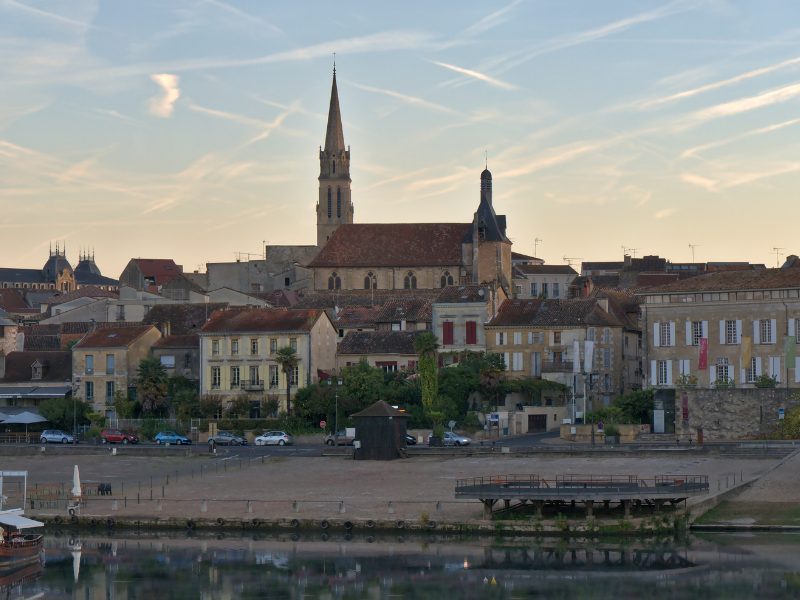
The medieval bastion of Bergerac is Dordogne’s second largest town, celebrated for Cyrano de Bergerac, its historic vieille ville (Old Town) and delicious local wine.
From the pretty Place Pelissière, the old-town streets lead down to the Dordogne River and up to the modern center.
A statue of Cyrano de Bergerac, a famous historical French figure frequently immortalized in films, stands in the attractive town square.
Surrounding Bergerac are the largest vineyards of Dordogne, including the renowned sweet wines of Monbazillac, a magnificent château set on rolling hills to the south of the town.
Issigeac
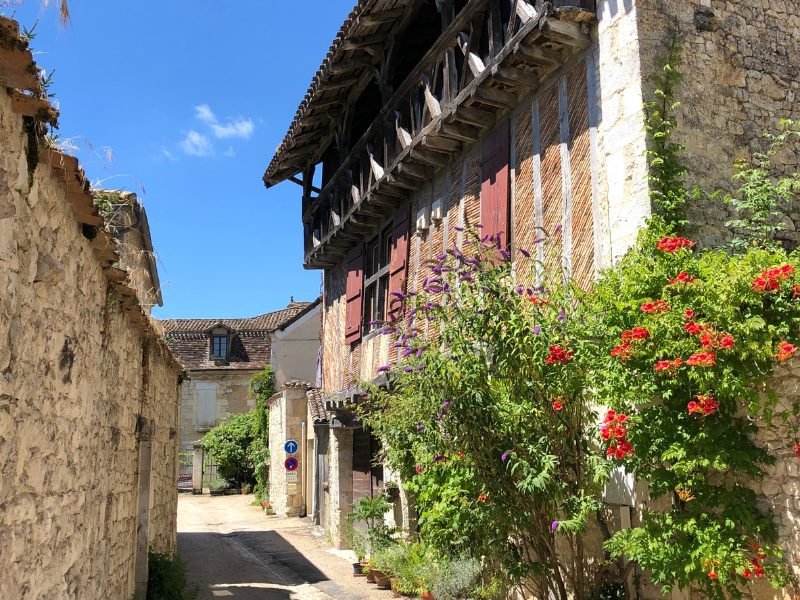
Nestled in the very south of Dordogne is Issigeac, another age-old Périgord village where time has stood still for centuries.
It’s a sleepy settlement of wonderful narrow winding streets and superb half-timbered homes that really comes alive for the celebrated Sunday market.
And like so many of these medieval Dordogne villages, it’s at its most vibrant in summer when the night market – a tradition in the whole region – is in full swing.
Monpazier
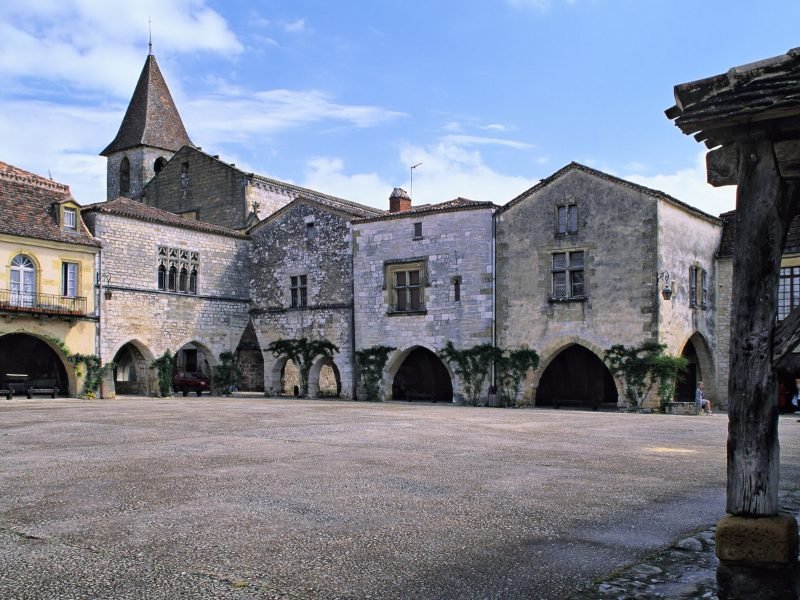
The Périgord Pourpre has two official plus beaux villages of France, and Monpazier is one of them.
Straddling the southern border of Dordogne, this is a 13th century bastide town with a beautifully preserved medieval center.
With a handsome central square housing a halle (covered wooden marketplace) and edged all around with flawlessly formed enclosed archways, it is often cited as the favorite bastide town of the region.
Monpazier celebrates its longstanding heritage with the Medieval Day festival every July, an unmissable time to be in town.
Cadouin
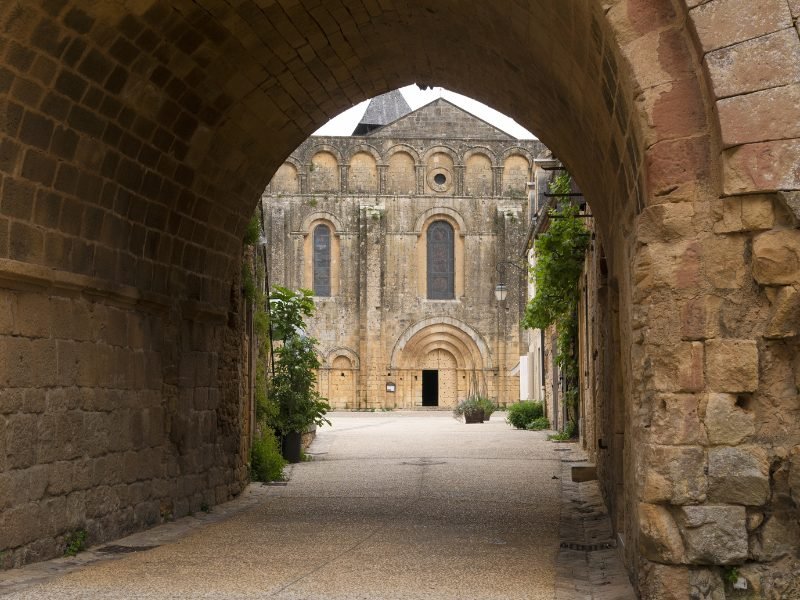
The little village of Cadouin is a lovely surprise!
Just a one-street settlement yet so worth a visit, Cadouin renowned for its remarkable 11th-century Cistercian Abbey and Gothic-era cloisters.
These also form part of the UNESCO World Heritage Site along the Pilgrim route to Santiago de Compostella.
The charming village square comprises some appealing boutique stores and places to eat.
It also has an impressive covered halle constructed with stone pillars instead of the usual wood design that dominates in many Dordogne towns and villages.
Close by Cadouin, the Dordogne River is an inviting place to stop for a swim and a picnic on a hot summer’s day.
Limeuil
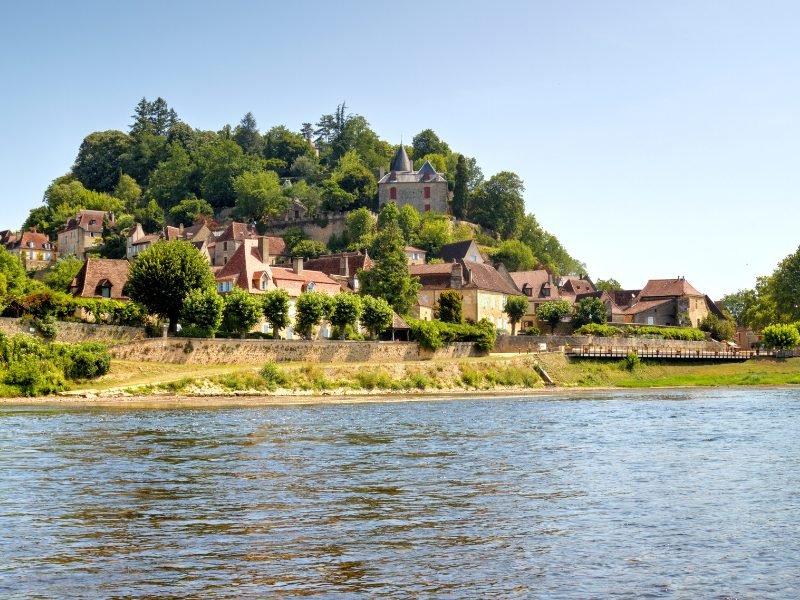
We end our circuit of the sightseeing highlights of Dordogne in Limeuil, the last of the plus beaux villages on the official department list.
Located at the confluence of the Dordogne and Vézère rivers, Limeuil is a medieval treasure atop a lofty promontory with gorgeous valley vistas.
Stroll the pretty winding streets upwards and upwards to the top of the village.
Overlooking the most sublime natural setting, there is the Jardins Panoramiques, scenic gardens set in the grounds of an old fortified castle with some of the most photogenic views in all of Dordogne.
Unwind after your uphill hike to the gardens at the riverside beaches; relax in the summer sun, swim in the rapids, or rent a canoe or kayak for a scenic river jaunt.